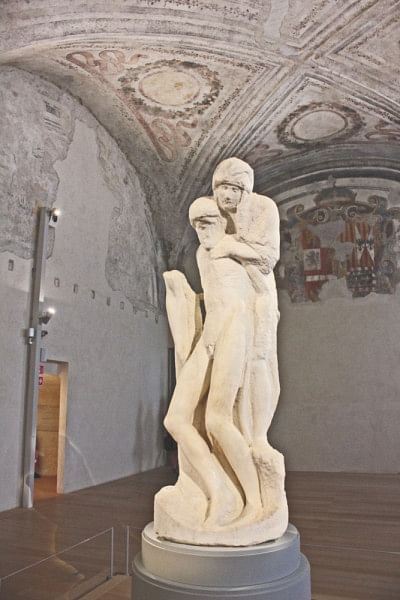Rondanini Pietà: Michelangelo's final masterpiece

As part of a short-term scholarship by Institut für Auslandsbeziehungen to the Deutsche Welle Akademie, I had the opportunity to spend two months in Germany, and I tried to make the most of my time by utilizing the weekends to see as much of Europe and its arts as possible. On one such trip to Milan, Italy, I stumbled upon, rather accidentally, on one of the final works of master sculptor Michelangelo, and it was an almost overwhelming experience.
After failing to secure tickets to see Leonardo da Vinci's “The Last Supper” which is housed in the city (tickets for which sell out online weeks in advance) due to a poorly-planned trip, I decided to walk around at the Sforza Castle courtyard, where gorgeous sculptures were a common sight. It was there that I came across a sign that said the Rondanini Pietà by Michelangelo Buonarroti, one of the greatest sculptors of all time, was kept. It took me a while to find the entrance to the exhibit. At the gate, however, the usher asked me to come back in about half an hour. Since there was not much of a crowd inside, I asked why, and he explained that for the last hour of the exhibit (4-5pm), entry was free, so I shouldn't be buying the tickets.
Pietà, a prominent subject of Christian art, is the depiction of Virgin Mary cradling the dead body of Jesus Christ. It has been undertaken by many artists, but none as famous as Michelangelo himself. His main work on the theme, at the St. Peter's Basilica in Vatican City, is one of the most remarkable works of sculpture of all time. But the Rondanini Pietà is distinctive from it, in a few ways. Michelangelo created the one at the St Peter's Basilica when he was 25, with a well-defined, healthy-looking body of Jesus on the knees of a youthful Mother Mary. The Rondanini Pietà, which was found unfinished in his studio at the time of his death in 1954, shows two rather elongated bodies almost fused together, with Mother Mary mourning over the body of Jesus. He is said to have worked on it for nearly a decade, into his eighties, and his changing idea of beauty, spirituality and growing sense of mortality is ever-evident in the work.
The sculpture is rather aptly placed in the former hospital section of the castle's courtyard of arms, a place that has seen suffering and prayers. From a rear angle, it almost looks like Jesus is holding up the body of Mary, rather than the opposite. It is said that Michelangelo intentionally carved it that way as a representation of how Jesus' spirit was comforting Mary for her loss. After his death, the sculpture disappeared and only resurfaced in 1807 in the palazzo of the marchesi Rondinini, hence the name. After several change of hands, it was purchased by the city of Milan in 1952 by a public-raised fund, and went up on display at the Sforza Castle in 1956.
The power of art lies in being in its presence. Reading books and scholarly pieces and watching photos and videos can only give you information about any work of art, but the feeling of awe and marvel can only be felt while standing in front of it. And it was a moment of revelation to be in presence of the final piece of work by one of the greatest artists who ever lived.

 For all latest news, follow The Daily Star's Google News channel.
For all latest news, follow The Daily Star's Google News channel. 



Comments